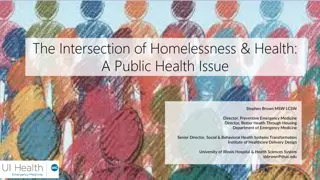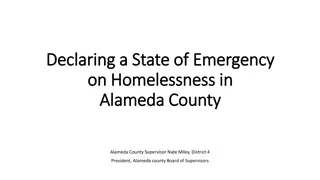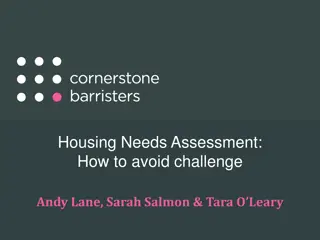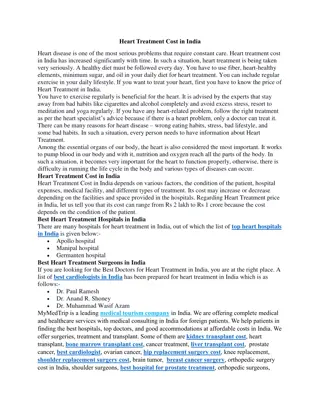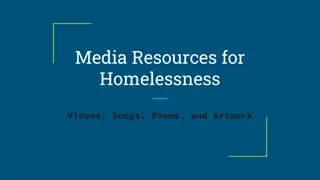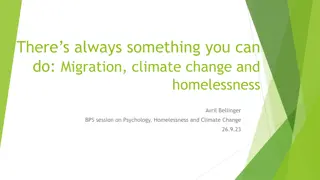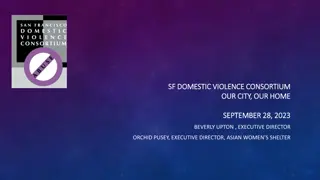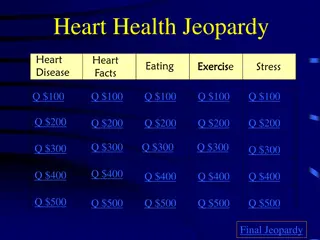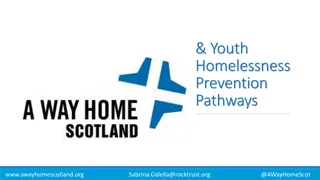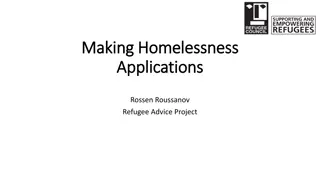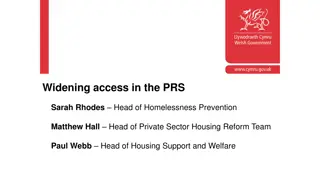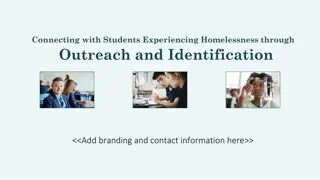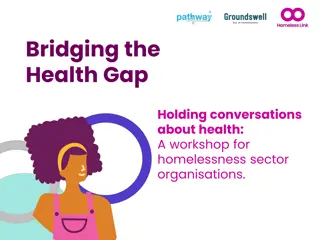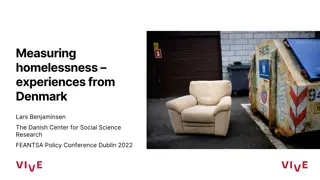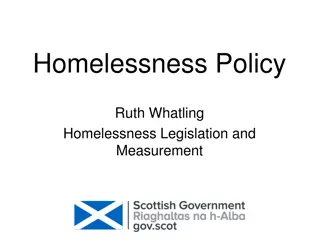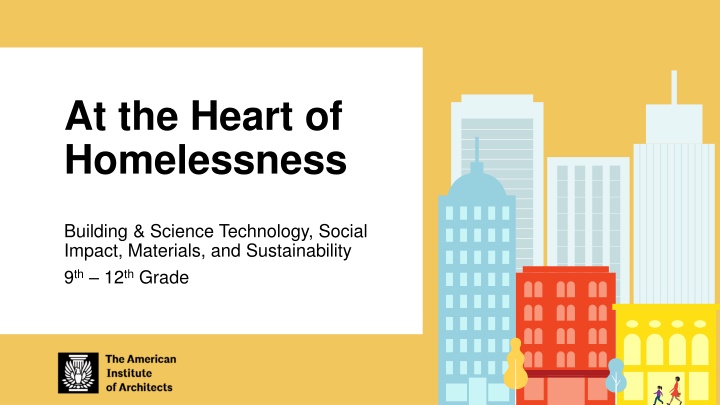
Innovative Solutions for Homelessness: Building a Better Future
Explore the intersection of science, technology, social impact, materials, and sustainability in addressing homelessness. Students embark on a project to design housing structures on donated land to help the homeless population. Through research, creative solutions, and collaboration, they aim to make a positive difference in urban communities.
Download Presentation

Please find below an Image/Link to download the presentation.
The content on the website is provided AS IS for your information and personal use only. It may not be sold, licensed, or shared on other websites without obtaining consent from the author. If you encounter any issues during the download, it is possible that the publisher has removed the file from their server.
You are allowed to download the files provided on this website for personal or commercial use, subject to the condition that they are used lawfully. All files are the property of their respective owners.
The content on the website is provided AS IS for your information and personal use only. It may not be sold, licensed, or shared on other websites without obtaining consent from the author.
E N D
Presentation Transcript
At the Heart of Homelessness Building & Science Technology, Social Impact, Materials, and Sustainability 9th 12thGrade
Overview: A plot of land has been donated to help make a positive impact on the homeless population in an urban area. Students will demonstrate their understanding of the social issue of homelessness through innovative design solutions for a housing structure.
Table of Contents Problem Guide Problem Resources Student Problem Key Facts Need to Knows Learning Issues Additional Information Interdisciplinary Connections Hypotheses Learning Issue Resource Guide Final Product/Writing Guide Rubric 4 5 6 7 8 9 10 11 12 13 14 15
Problem Guide Timeframe This lesson plan will take approximately five weeks. Have each team begin a list of POSSIBLE HYPOTHESES [page 12]. Step-by-step guide Allow teams to research and explore the LEARNING ISSUES [pages 9 & 13]. Put students into teams of three to five members. Teams reevaluate their POSSIBLE HYPOTHESES [page 12] and determine one DEFENDABLE SOLUTION for the Final Product [page 14]. Ask for a volunteer to read the STUDENT PROBLEM aloud [page 6]. As a whole group, ask students to list What We Know [KEY FACTS, page 7]. Teams create and present their DEFENDABLE SOLUTION [page 14]. Have each team create a list of What We Need to Know [NEED TO KNOWS & LEARNING ISSUES, pages 8 and 9].
Problem Resources Resources provided Included with this case are: AIA Challenging Architects to Collaborate on Housing Needs Website AIA Tiny Townhomes Website AIA Homeless Shelter [re]Typology Website AIA Community by Design: Skid Row Housing Trust Website Community Service Council Housing and Homelessness Initiative Website National Coalition for the Homeless Building a Movement to End Homelessness Website Homelessness Awareness Activity Unsheltered Lives Activity Guide
Student Problem A group of philanthropists in an urban area has donated a plot of land (about 2.41 acres 350 x 300 ) to make a positive impact on the homeless population in the area. They re looking for a variety of ways to make the best use of the property. They re requesting that each interested firm submit three potential solutions that demonstrate innovative, forward-thinking design options. Consider: What design solutions would have a positive impact on the homeless population? What use of the plot of land will have the most impact?
Key Facts A group of philanthropists has donated a plot of land that is approximately 2.41 acres 350 x 300 . The plot of land is located in an urban area. The plot of land is to be used to make a positive impact on the homeless population in the area. The philanthropists would like to see a variety of ways to make the best use of the property. Each interested firm must submit three potential solutions. The potential solutions should demonstrate innovative, forward- thinking design options.
Need to Knows Need to Knows Need to Know Answers In which urban area is the plot of land located? Facilitator may choose to use their own hometown or somewhere local that students will be familiar with. Is there a budget for the cost of the proposed solutions? There is no budget for the cost of the proposed solutions. What is the current landscape of the plot of land? Facilitator may provide a current landscape or leave this for the students to decide. How will we present our design? Facilitator may decide how students will present their final product, with a focus on a visual representation or rendering of the three potential solutions.
Learning Issues Learning Issue Resources Learning Issues Students will investigate using the Learning Issue Resource Guide, page 13. What is the homelessness issue? What needs are a priority for the homeless? What structures can be built in the space provided? How can our created designs demonstrate variety and innovation? How will the designs make a positive impact on the homeless population?
Additional Information Students should individually generate at least one possible hypothesis to bring to their team. As a team, students will define their problem statement and generate multiple hypotheses for possible solutions. Teams can demonstrate their understanding of the homelessness issue by designing three innovative solutions for the plot of land. The facilitator may decide what materials and technology may be used to test possible solutions. Teams should reevaluate their possible hypotheses after testing possible solutions and choose one to create their presentation.
Interdisciplinary Connections Math: Social/Emotional: How to work in teams and problem solving Responding to the needs of the community Social Studies: Urban social issues: homelessness Cause and effect Prevention Economic issues Reasoning Modeling Science: Ecosystems Sustainability English: Research practices Presentation practices Art: Design
Hypotheses Hypotheses will vary by each team s three potential solutions for the plot of land. Hypotheses will vary by the explanations provided for the design choices of each team s solutions.
Learning Issue Resource Guide AIA Challenging Architects to Collaborate on Housing Needs www.aia.org/articles/19211-challenging-architects- to-collaborate-on-hou Community Service Council Housing and Homelessness Initiatives csctulsa.org/housing-homelessness/ National Coalition for the Homeless Building a Movement to End Homelessness nationalhomeless.org/references/teaching/ AIA Tiny Townhomes www.aia.org/showcases/62311-tiny-townhomes- affordability-by-design Hands-on Extension Activities: Homelessness Awareness Activity Unsheltered Lives Activity Guide AIA Homeless Shelter [re]Typology www.aia.org/showcases/13591-homeless-shelter- retypology AIA Community by Design: Skid Row Housing Trust www.aia.org/videos/161451-community-by-design- skid-row-housing-trust
Final Product and Writing Guide Team Each team will create and present their three innovative housing solutions for the plot of land that detail the necessary materials and forward-thinking architectural components and opportunities that will benefit the homeless population.
Rubric Final Product and Writing Guide Above Average Three points each Two points each Average Below Average One point each No Evidence Zero points each Area Points Team Each team will create and present their design for the new downtown park. Teams will include an explanation of the accessible and sustainable design features that demonstrate their understanding of an equitable community space. Solution and defense well presented Few Learning Issues addressed One hypothesis present Low-quality final product All Learning Issues addressed Three or more hypotheses present High-quality final product Most Learning Issues addressed Two hypotheses present Roles somewhat defined Fair-quality final product No Learning Issues addressed No hypotheses present No final product Final Product Problem Summary, Learning Issues, & new information integrated and well presented Hypotheses well presented Problem Summary, Learning Issues, & new information integrated and presented Hypotheses presented Solution and defense presented Problem Summary, Learning Issues, & new information integrated and poorly presented Hypotheses poorly presented Solution and defense poorly presented Problem Summary, Learning Issues, & new information integrated and not presented Hypotheses not presented Solution and defense not presented Writing Assessment Individual works well with group members Individual communicates well with group members Individual carries out their individual responsibilities Individual works acceptably with group members Individual communicates acceptably with group Individual mostly carries out their individual responsibilities Individual does not work well with group members Individual does not communicate well with group members Individual attempts but fails to carry out individual responsibilities Individual interferes with group members Individual does not communicate at all Individual does not attempt to carry out their individual responsibilities Collaboration 24 27 Points = Above Average 15 23 Points = Average 6 14 Points = Below Average 0 6 Points = Failing
Final Product and Writing Guide Team Each team will create and present their design for the new downtown park. Teams will include an explanation of the accessible and sustainable design features that demonstrate their understanding of an equitable community space. Project consultants: Center of Excellence for Research, Teaching and Learning (CERTL) at Wake Forest School of Medicine


